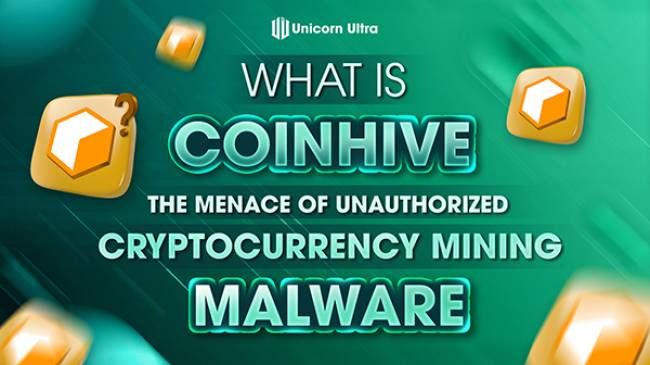In the realm of cybersecurity threats, Coinhive has gained notoriety as a malicious form of malware. So, what is coinhive malware? This blog post aims to shed light on Coinhive's nature, operation, and preventive measures against its infiltration. We will delve into the workings of this malware, identify signs of infection, and provide guidelines for network administrators, website administrators, and users to prevent the intrusion of Coinhive malware.
Table of Contents
Information about Coinhive malware

What is Coinhive?
What is coinhive? Coinhive is a type of malware that harnesses the computational power of website visitors to mine cryptocurrencies, specifically Monero (XMR). This malware employs JavaScript-based mining scripts that are injected into websites without the knowledge or consent of visitors. The illicitly obtained computational resources are used to mine cryptocurrencies, benefiting the attackers.
How does Coinhive malware work?
Coinhive malware operates by stealthily injecting mining scripts into compromised websites. When unsuspecting visitors access these infected websites, their devices' processing power is exploited to mine cryptocurrencies on behalf of the attackers. This unauthorized mining consumes the visitors' resources, leading to increased CPU usage, slower performance, and reduced battery life.
What is the penetration of Coinhive malware?
Coinhive malware has infiltrated numerous websites, exploiting security vulnerabilities or using compromised credentials to gain unauthorized access. This widespread penetration has affected websites across various industries, including government, education, and e-commerce. The malware's covert nature makes it challenging to detect and mitigate.

Signs of Coinhive malware infection
Detecting Coinhive malware requires vigilance and attention to certain signs. Increased CPU usage, prolonged periods of sluggish performance, and overheating devices are common indicators. Furthermore, users may notice battery drain on mobile devices or encounter frequent antivirus alerts and warnings about unauthorized mining activities.
Preventive measures against Coinhive malware
For network administrators, how to avoid Coinhive?
Network administrators play a crucial role in protecting against Coinhive malware. Implementing robust security measures such as firewalls, intrusion detection systems, and regularly patching vulnerabilities can help prevent unauthorized access. Conducting thorough security audits, monitoring network traffic, and employing advanced threat intelligence solutions are also recommended.

For website administrators, how to avoid Coinhive malware?
Website administrators must take proactive steps to safeguard their platforms against Coinhive malware. Regularly updating content management systems, plugins, and themes is crucial to patching vulnerabilities that can be exploited by attackers. Implementing strong access controls, conducting security scans, and monitoring for suspicious activities can help identify and mitigate potential breaches.
For users, how to avoid Coinhive malware?
Users can protect themselves from Coinhive malware by practicing safe browsing habits. Installing reputable antivirus software and keeping it up to date is essential. Additionally, being cautious when visiting unfamiliar or suspicious websites, avoiding clicking on suspicious links or downloading unknown files, and regularly clearing browser cache and cookies can minimize the risk of infection.
Coinhive malware represents a significant threat in the cybersecurity landscape, exploiting unsuspecting website visitors for unauthorized cryptocurrency mining. By understanding what is coinhive, its operation, recognizing signs of infection, and implementing preventive measures, network administrators, website administrators, and users can fortify their defenses against this intrusive malware. Collaborative efforts, awareness, and adherence to security best practices are crucial in combating Coinhive and similar threats to maintain a safe online environment. Follow https://uniultra.xyz/ for more blockchain updates.






